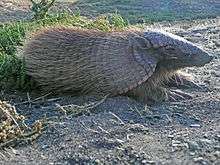Euphractinae
Euphractinae is an armadillo subfamily in the family Chlamyphoridae.
| Euphractinae | |
|---|---|
 | |
| Chaetophractus vellerosus | |
| Scientific classification | |
| Kingdom: | Animalia |
| Phylum: | Chordata |
| Class: | Mammalia |
| Order: | Cingulata |
| Family: | Chlamyphoridae |
| Subfamily: | Euphractinae Winge 1923 |
| Genera | |
| |
Taxonomy
It contains the following genera:[1]
- Chaetophractus, hairy armadillos
- Euphractus, six-banded armadillos
- Zaedyus, pichis
Extinct genera include:[2]
- Paleuphractus
- Doellotatus
- Proeuphractus
- Macroeuphractus
Phylogeny
A mitochondrial DNA investigation has concluded that Euphractinae is the sister group of a clade consisting of Chlamyphorinae (fairy armadillos) and Tolypeutinae (giant, three-banded and naked-tailed armadillos)[3] along with extinct glyptodonts,[4] as shown below.
| Cladogram[4][5][6] | |||||||||||||||||||||||||||||||||||||||||||||||||||||||||||||||||||||||||||||||||||||||||||||
|
gollark: That unless you coercively obliterate all humans at once, it won't actually work.
gollark: The most obvious objection is that there's selection pressure against voluntarily extincting yourself.
gollark: Oh, of course you're looking at that.
gollark: I feel like you're just recapitulating the Minoteaur login page.
gollark: That doesn't implement Sized, silly.
References
- "Euphractinae". Integrated Taxonomic Information System. Retrieved 22 March 2011.
- Mitchell, Kieren J.; Scanferla, Agustin; Soibelzon, Esteban; Bonini, Ricardo; Ochoa, Javier; Cooper, Alan (2016). "Ancient DNA from the extinct South American giant glyptodont Doedicurus sp. (Xenarthra: Glyptodontidae) reveals that glyptodonts evolved from Eocene armadillos". Molecular Ecology. 25 (14): 3499–3508. doi:10.1111/mec.13695. PMID 27158910.
- Gibb, G. C.; Condamine, F. L.; Kuch, M.; Enk, J.; Moraes-Barros, N.; Superina, M.; Poinar, H. N.; Delsuc, F. (2015-11-09). "Shotgun Mitogenomics Provides a Reference Phylogenetic Framework and Timescale for Living Xenarthrans". Molecular Biology and Evolution. 33 (3): 621–642. doi:10.1093/molbev/msv250. PMC 4760074. PMID 26556496.
- Delsuc, F.; Gibb, G. C.; Kuch, M.; Billet, G.; Hautier, L.; Southon, J.; Rouillard, J.-M.; Fernicola, J. C.; Vizcaíno, S. F.; MacPhee, R. D. E.; Poinar, H. N. (2016-02-22). "The phylogenetic affinities of the extinct glyptodonts". Current Biology. 26 (4): R155–R156. doi:10.1016/j.cub.2016.01.039. PMID 26906483.
- Upham, Nathan S.; Esselstyn, Jacob A.; Jetz, Walter (2019). "Inferring the mammal tree: Species-level sets of phylogenies for questions in ecology, evolution and conservation". PLoS Biol. 17 (12). doi:10.1371/journal.pbio.3000494.
- Gibb, Gillian C.; Condamine, Fabien L.; Kuch, Melanie; Enk, Jacob; Moraes-Barros, Nadia; Superina, Mariella; Poinar, Hendrik N.; Delsuc, Frédéric (2015). "Shotgun Mitogenomics Provides a Reference PhyloGenetic Framework and Timescale for Living Xenarthrans". Molecular Biology and Evolution. 33 (3).
This article is issued from Wikipedia. The text is licensed under Creative Commons - Attribution - Sharealike. Additional terms may apply for the media files.